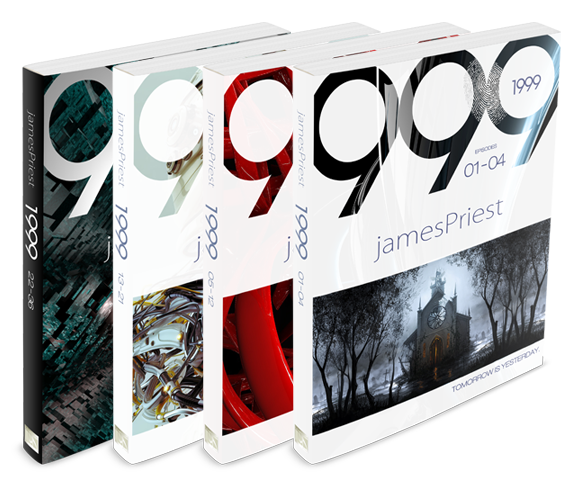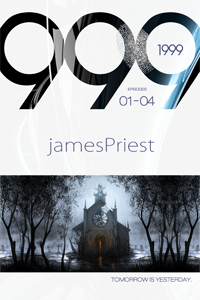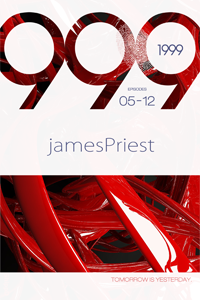
Tomorrow Is Yesterday.
Taking place over the 1998 Christmas holiday, 1999
contains three distinct series written in different genres and set in a modular shared universe:
Crimson, a Manga-influenced
martial arts action series about a super-powered
Korean American teenage girl hunted across the Korean peninsula;
Eddie X, a medical drama about a second-year surgical
resident who moonlights as a
contract killer; and The Zionist, a political drama about a Will Smith-type
college student who inherits a house built in a Jewish
settlement in the Gaza Strip.
As with the film Crash, 1999’s three independent series,
which have, seemingly, nothing in common, intersect at a common
event: a hold-up at a Newark bar.
A fourth series, eponymously titled 1999, is an
over-arching police procedural drama about NYPD Detective Evan Dwyer, who was
moonlighting off-the-books at that Newark bar and whose job is
now in jeopardy because of the robbery. Dwyer is desperate to
solve the crime and apprehend the suspects before his review
board hearing after the Christmas holiday. His single piece of
evidence is a thumb print on a bar glass.
Running the fingerprint through various agencies, Dwyer
assembles a list of suspects, most of whom he chalks up to false
positives and the crude state of computer print-checking in
1998. What he discovers, however, is a deeper mystery: hundreds
of hits—exact matches—to his bar glass fingerprint, ultimately
discovering more than a thousand possible suspects.
The Dwyer arc interacts with the disparate series and characters
as Dwyer discovers these people, who do not know one another,
have nothing in common, and vary in ethnicity, age and gender,
are somehow linked by a shared paranormal ability.
Thank You: Elysee, Darren Shipp, Vladislav Ociacia, Steven Becker, and Brandon McCormick
This should have been a comic book.
I’d actually have liked this to have been a comic book, but from
conception I realized it wasn’t likely to be. This is mainly
about economics: comics have become prohibitively expensive to
produce. Originally conceived during the war years as cheap
entertainment, comics now retail at about five dollars apiece.
This is good for retailers—although most brick-and-mortar chain
stores still refuse to carry them even at that attractive price
point—but it is bad for consumers who, with each cover price
hike, are forced to narrow their choices from walls loaded with
titles all vying for the same shrinking pool of devoted readers.
Even worse: the pacing in comics has slowed to an absolute
crawl. Most tell a fragment of a story at a glacially
slow pace such that a story that once might have occupied one or
two issues now takes a full year or even longer to tell.
Given this industry environment, it's unlikely a comics
publisher could guarantee thirty-six issues of any series will see print. No
company has the budget to produce
thirty-six issues of a series and hold them in
order to release the entire series all at once
as a graphic novel or individually for binge
reading.
So, I thought of the next best thing: a revival of the old
“Pulp” series format: 80-100 pages per issue of prose along with
color plates of graphic art. Use the now-industry standard slick
coated paper for the art signatures while using the absolutely
most dreadful paper we could find—very cheap newsprint or
worse—for the text. Blend art and text in some imaginative way
for digital editions.

Energy Ribbon: Abstract by Brandon McCormick © 2015
Cheap Entertainment
I thought, and still believe, comics should be cheap, or at
least affordable entertainment. Sure, there’s a market for the
higher-end stuff—for collectors who buy one and bag one—but I
believe comics were birthed into existence for the little kid
with the skateboard who’d roll them up and shove them into his
back pocket. We don’t sell to that kid anymore. We don’t even
know where to find him.
Conceived in 2007 for a 2008 release, 1999 was written,
essentially, as a comic book written in prose form. Here, in
this 99¢ volume, are four little stories. In the next volume,
there are eight little stories. Each episode is paced and
written to the length of an issue of a comic book; the
equivalent of four issues, $20 of comics stories, for less than
one dollar.
Of course, you’re not reading a comic book because, if you
were, it would sell very few copies because the
publisher would not know how to find you.
This edition has no pictures in it. That version of the project
will now be called 1999 Illustrated and we may see that one day,
especially if this little digital text version finds an
audience. For now, you’ll have to make up our own pictures in
your head, which (he said, sarcastically) is called “reading.”
1999 was conceived as a serial, and so I am attempting to
present it as such. This will likely irritate book readers who
may not understand why I breaking the story up into several
different editions; why not just package the whole thing and be
done with it. Well, that’s not how I intended this work to be
consumed. Which isn’t to say there’ll never be 1999: The
Complete Series, but that, for now at least, I’d prefer to
release it in as close to its original form as I am able.
The Kindle version can be downloaded
here.
Volume One is only 99¢ and you don't need to own a Kindle (or
even a tablet) to read it. If you grab it, please do me a solid and post a
comment on Amazon, let me know what you think.
Christopher J. Priest
29 September 2015
Home | Blog | Projects | Comics | Rants | Music | Video | Christian Site | Contact
Swingset by Base Jase
Copyright © 2015 Illynoise Muisc, Jason Williamson Music (BMI)
Unless otherwise specified, text Copyright © 2015 Lamercie Park. All Rights Reserved.
TOP OF PAGE








